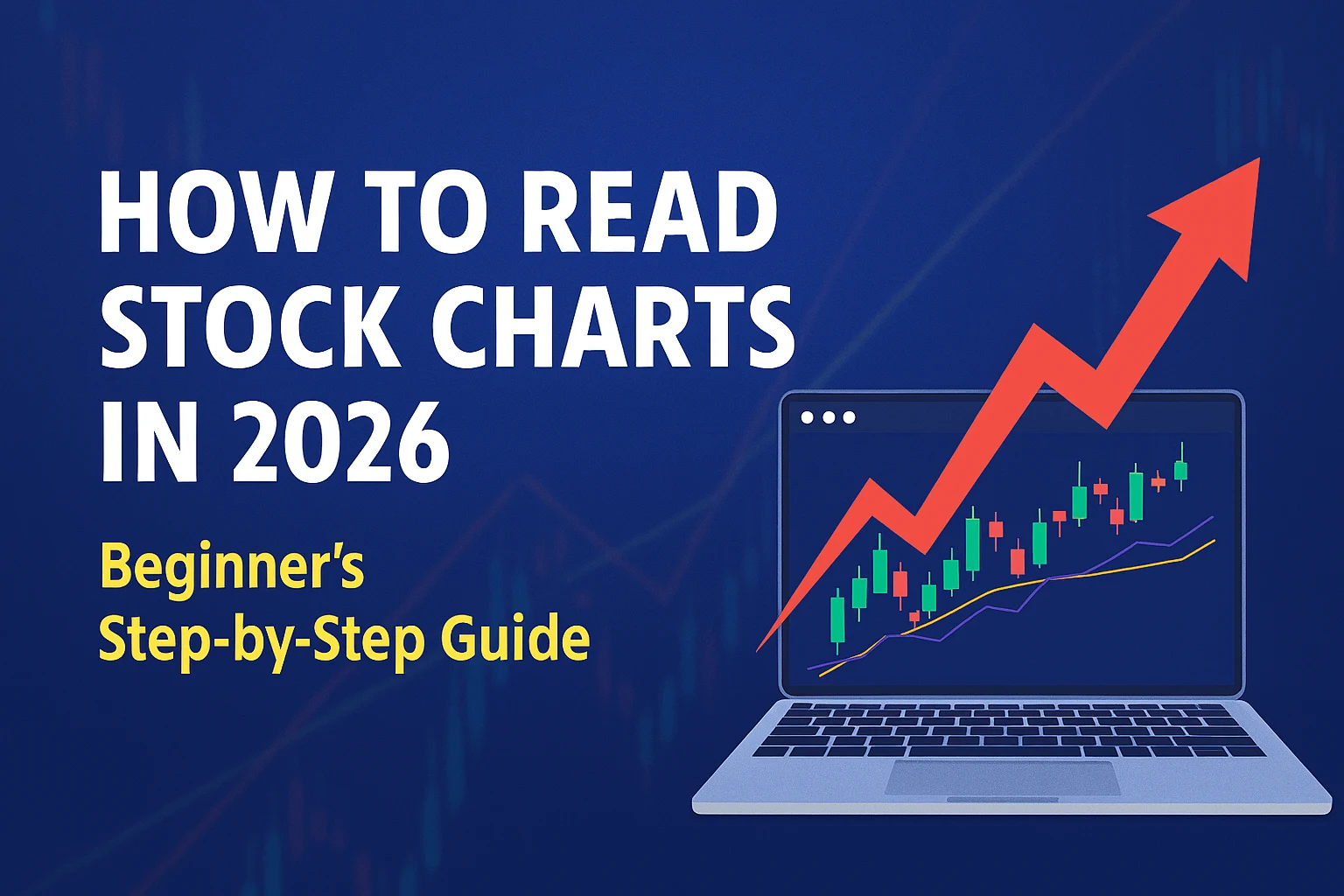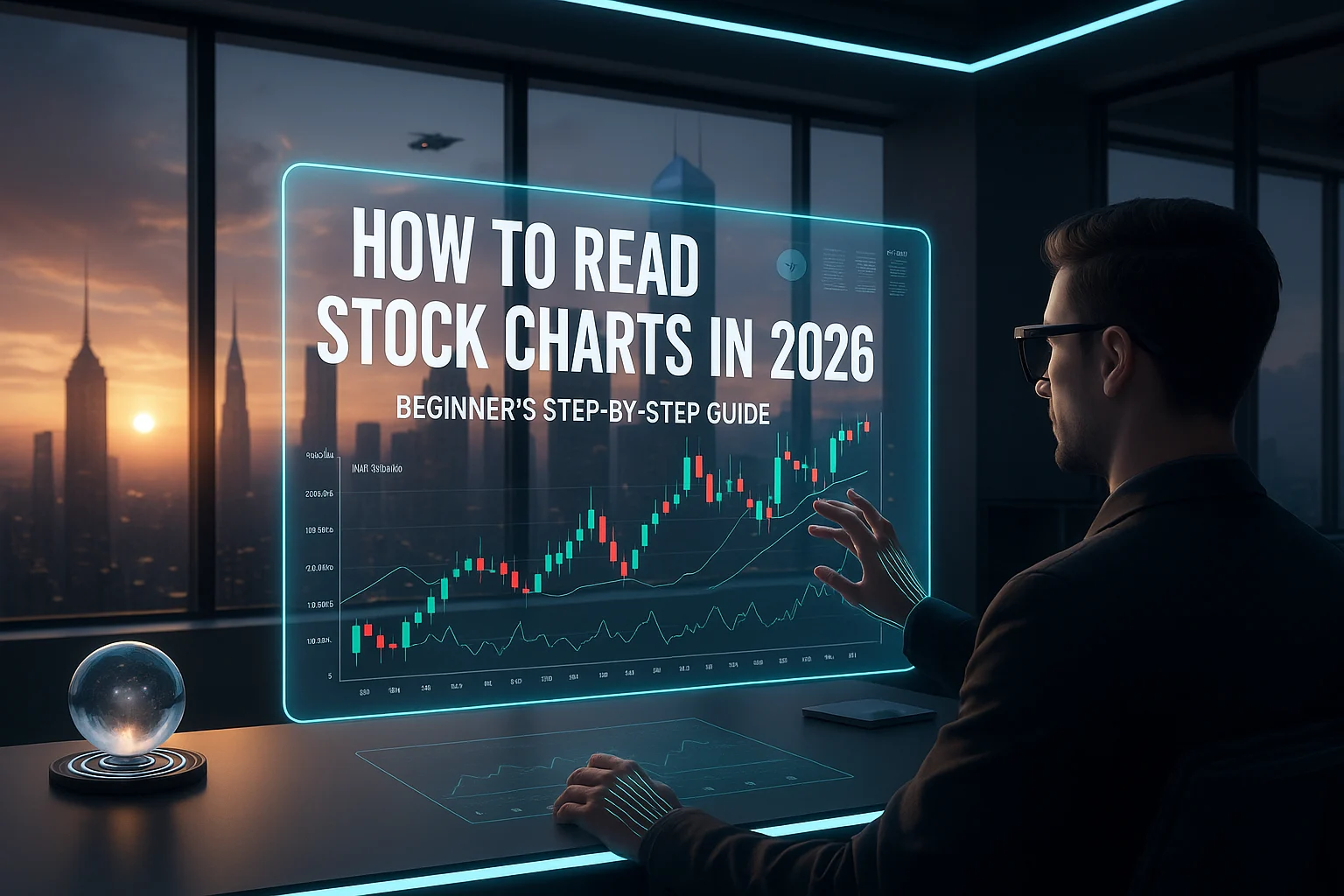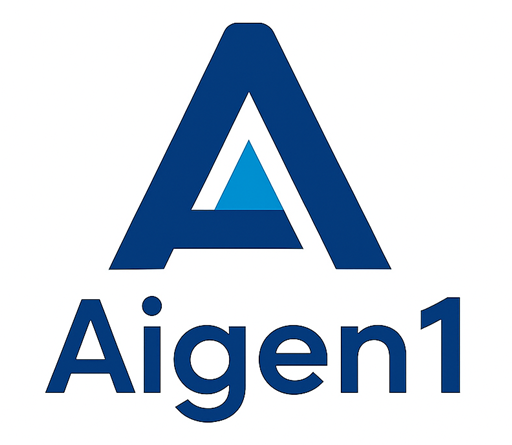Introduction to Stock Chart Reading
In the dynamic world of investing, learning how to read stock charts is essential for beginners aiming to make informed decisions. Interpreting stock charts allows you to visualize price movements over time, spot trends, and predict potential shifts. Moreover, stock chart analysis has evolved with technology, and by 2026, AI-driven tools will enhance this process significantly. For instance, platforms now integrate real-time data and predictive analytics, making it easier than ever to understand market behavior.
However, starting out can feel overwhelming. That’s why this guide focuses on the fundamentals while incorporating future trends. Additionally, we’ll explore key synonyms like decoding stock graphs to broaden your vocabulary. As markets broaden in 2026 with expected earnings growth of 12.1%, mastering these skills could boost your portfolio. Therefore, let’s dive into the basics, ensuring you gain confidence step by step.
Transitioning from theory to practice, remember that consistent practice refines your ability. Furthermore, with AI booming, tools like automated pattern recognition will be commonplace by 2026. Consequently, beginners should start with free platforms to experiment without risk.
Table of Contents
- Introduction to Stock Chart Reading
- Understanding the Basics of Stock Charts
- Key Elements of a Stock Chart
- Step-by-Step Guide to Interpreting Stock Charts
- Common Stock Chart Patterns Every Beginner Should Know
- Technical Indicators for Enhanced Stock Chart Analysis
- Stock Market Trends and Tools for 2026
- Advanced Tips for Mastering Stock Charts in 2026
- FAQ: Common Questions on How to Read Stock Charts

Understanding the Basics of Stock Charts
How to Read Stock Charts
A stock chart is a graphical representation of a stock’s price history, volume, and other data over a specified period. Essentially, it helps in stock chart reading by displaying how prices fluctuate. For beginners, think of it as a roadmap for investment journeys. Moreover, in 2026, these charts will increasingly incorporate AI overlays for instant insights.
Additionally, charts come in various time frames, from intraday to yearly views. However, the core purpose remains: to aid in interpreting stock charts for better trading strategies. For example, spotting upward trends early can signal buying opportunities. Therefore, familiarizing yourself with chart components is crucial.
Furthermore, as markets evolve, understanding these visuals becomes more vital. Consequently, beginners should select user-friendly apps that offer customizable views.
Types of Stock Charts: Line, Bar, and Candlestick
Line charts are the simplest, connecting closing prices to show overall trends. They excel in basic stock chart analysis but lack detail on daily highs and lows. Bar charts, on the other hand, provide more information with vertical lines indicating high-low ranges and horizontal ticks for open-close prices.
However, candlestick charts are the most popular for detailed interpreting stock charts. Each “candle” shows open, high, low, and close prices, with colors denoting gains (green) or losses (red). Additionally, in 2026, enhanced candlestick patterns via AI will predict reversals more accurately. For instance, a doji candle signals indecision. Therefore, start with candlesticks for comprehensive insights.
Moreover, transitioning between types helps in cross-verification. Consequently, use line for long-term views and candlesticks for short-term trades.
Key Elements of a Stock Chart
How to Read Stock Charts
The vertical axis represents price levels, scaling from low to high. Horizontal axis shows time, adjustable from minutes to years. Together, they form the backbone for how to read stock charts effectively.
Furthermore, logarithmic scales may appear in advanced charts for proportional changes. However, beginners should stick to linear scales initially. Additionally, in 2026, interactive axes with zoom features will make navigation seamless. For example, hovering over points might display exact values. Therefore, always check the scale to avoid misinterpretation.
Consequently, practicing with different time frames builds intuition. Moreover, this setup aids in spotting long-term patterns.
Volume Bars and Their Significance
Volume bars at the chart’s bottom indicate trading activity. High volume confirms strong trends, while low suggests weakness. In stock chart reading, volume spikes often precede price moves.
Moreover, divergences—where price rises but volume falls—signal potential reversals. However, combining volume with price action enhances accuracy. Additionally, by 2026, AI tools will analyze volume anomalies in real-time. For instance, unusual surges might flag news events. Therefore, never ignore volume; it’s a key validator.
Furthermore, tracking volume trends over weeks provides context. Consequently, it refines your interpreting stock charts skills.

Step-by-Step Guide to Interpreting Stock Charts
How to Read Stock Charts
Begin by assessing if the stock is in an uptrend, downtrend, or sideways movement. Draw trend lines connecting highs or lows. Uptrends show higher highs and lows, ideal for buying.
However, downtrends indicate selling pressure. Additionally, in 2026, AI will automate trend detection, but manual checks build foundational skills. For example, a series of rising peaks confirms bullishness. Therefore, always start here in your stock chart analysis routine.
Moreover, use multiple time frames for confirmation. Consequently, this avoids false signals.
Spot Support and Resistance Levels
Support is a price floor where buying interest emerges, while resistance is a ceiling where selling dominates. These levels guide entry and exit points in how to read stock charts.
Furthermore, breakouts above resistance signal strength. However, false breakouts occur, so confirm with volume. Additionally, in 2026, predictive models will forecast these levels dynamically. For instance, repeated bounces off support indicate reliability. Therefore, mark them clearly on your charts.
Consequently, trading near these zones minimizes risk. Moreover, practice drawing them on historical data.
Analyze Price Action and Patterns
Examine how prices move within the chart. Look for consolidations or volatility spikes. This step refines interpreting stock charts by revealing market sentiment.
However, combine with indicators for depth. Additionally, common actions include gaps, which show overnight shifts. For example, an earnings gap up suggests positive news. Therefore, note unusual price behaviors promptly.
Furthermore, in 2026, real-time sentiment analysis from social media will integrate here. Consequently, it enhances pattern recognition.
Incorporate Technical Indicators
Add overlays like moving averages to smooth data. Simple moving averages (SMA) average prices over periods, signaling crossovers for buys/sells.
Moreover, RSI measures momentum, flagging overbought (>70) or oversold (<30) conditions. However, avoid relying solely on one indicator. Additionally, MACD shows trend changes via histogram. Therefore, use a combination for robust stock chart reading.
Consequently, backtest indicators on past charts. Furthermore, this builds confidence.
Make Informed Decisions
Synthesize all elements to decide on actions. For instance, a bullish pattern with high volume warrants buying. However, always set stop-losses.
Additionally, in 2026, AI advisors will suggest trades based on charts. Therefore, review your analysis periodically. Moreover, journaling trades improves over time.
Consequently, practice consistently for mastery.
Common Stock Chart Patterns Every Beginner Should Know
How to Read Stock Charts
The head and shoulders pattern signals a trend reversal from bullish to bearish. It features a peak (head) between two lower peaks (shoulders), with a neckline connecting lows.
However, confirmation comes on neckline breakdown. Additionally, its inverse predicts bullish reversals. For example, in volatile markets, this pattern appears frequently. Therefore, watch for volume increase on breakdown in stock chart analysis.
Moreover, measure the pattern’s height for target projections. Consequently, it aids in setting profit goals.
Continuation Patterns: Triangles and Flags
Ascending triangles show bullish continuation with flat resistance and rising support. Symmetrical triangles indicate consolidation before breakout.
Furthermore, flags resemble small rectangles after sharp moves, signaling pauses. However, breakouts align with prior trends. Additionally, in 2026, AI will scan for these in real-time. For instance, a bull flag after earnings suggests upward momentum. Therefore, time your entries accordingly.
Consequently, volume decrease during formation confirms validity. Moreover, practice spotting them.
Other Essential Patterns: Double Tops and Bottoms
Double tops form M-shapes, indicating bearish reversals after two failed highs. Double bottoms, W-shapes, signal bullish turns.
However, confirm with volume on breakouts. Additionally, these are reliable in trending markets. For example, a double bottom post-crash offers buy signals. Therefore, integrate them into your interpreting stock charts strategy.
Furthermore, use with indicators for strength. Consequently, reduce false positives.
Technical Indicators for Enhanced Stock Chart Analysis
How to Read Stock Charts
Moving averages calculate average prices over set periods, like 50-day SMA. Golden cross (short-term crossing above long-term) signals buys.
However, death cross indicates sells. Additionally, exponential moving averages (EMA) weight recent data more. For instance, in 2026, adaptive MAs will adjust to volatility. Therefore, use them for trend confirmation in how to read stock charts.
Moreover, multiple MAs provide support levels. Consequently, enhance entry points.
Momentum Indicators: RSI and MACD
RSI oscillates between 0-100, identifying overbought (>70) or oversold (<30) conditions. Values above 70 suggest selling, below 30 buying.
Furthermore, divergences predict reversals. However, MACD uses two lines and histogram for momentum shifts. Additionally, signal line crossovers generate trades. For example, bullish MACD in uptrends confirms strength. Therefore, combine for comprehensive stock chart reading.
Consequently, avoid overtrading on signals. Moreover, backtest in simulations.
Volume-Based Indicators: On-Balance Volume (OBV)
OBV adds volume on up days, subtracts on down days, tracking money flow. Rising OBV with prices confirms trends.
However, divergences warn of weaknesses. Additionally, in 2026, integrated with AI sentiment, it will be powerful. For instance, OBV uptick without price rise signals accumulation. Therefore, include it in your toolkit.
Furthermore, compare with price action. Consequently, spot hidden opportunities.
Stock Market Trends and Tools for 2026
Emerging Trends: AI and Broadening Markets
By 2026, AI will dominate stock chart analysis, offering predictive patterns and automated alerts. Earnings growth at 12.1% will broaden market participation beyond tech.
However, gold trends may hedge volatility. Additionally, rate cuts could fuel rallies. For example, S&P 500 is projected to rise 8%. Therefore, adapt charts to these dynamics. For more on gold as a hedge, see our guide on Best Ways to Invest in Gold 2026.
Moreover, focus on undervalued growth stocks. Consequently, diversify portfolios.
Advanced Tools: Real-Time Analytics and APIs
Platforms like TradingView will evolve with AI integrations for custom indicators. Real-time data feeds ensure accurate interpreting stock charts.
Furthermore, APIs allow programmatic analysis. However, beginners should use intuitive apps first. Additionally, voice-activated tools may emerge. For instance, querying “show RSI” instantly. Therefore, embrace tech for efficiency. Learn about AI-driven tools in our Smart Retirement Investment Planning 2026.
Consequently, stay updated via communities. Moreover, experiment safely.
Risk Management in 2026 Markets
With broadening rallies, volatility persists. Use stop-losses based on chart levels.
However, diversify across sectors. Additionally, monitor macro trends like inflation. For example, AI boom powers tech but watch overvaluations. Therefore, balance technicals with fundamentals. Explore risk management strategies in our Life Insurance in 2025-26 Guide.
Furthermore, journal for learning. Consequently, improve over time.
Advanced Tips for Mastering Stock Charts in 2026
Transitioning to advanced levels, integrate multi-chart views for correlations. For instance, compare sector ETFs.
However, avoid information overload. Additionally, use machine learning for pattern discovery. Moreover, in 2026, quantum computing might speed analyses. Therefore, stay educated on innovations.
Furthermore, backtest strategies using historical data. Consequently, refine approaches. For example, simulate AI-assisted trades. However, always verify manually.
Additionally, join online forums for insights. Therefore, accelerate learning.
Practice daily scans for patterns. Moreover, set alerts for key levels. However, combine with news feeds. For instance, geopolitical events impact charts instantly. Consequently, react swiftly but thoughtfully.
Furthermore, explore crypto charts for parallels. Therefore, broaden expertise. Additionally, in 2026, hybrid stock-crypto tools will emerge. For financing education to pursue trading, see our Education Loan Without Collateral in 2026.
FAQ: Common Questions on How to Read Stock Charts
Which chart type is most suitable for beginners?
Candlestick charts are ideal due to their detail on price action. However, start with lines for simplicity.
How do I choose the right time frame?
Use daily for swing trading, hourly for day trading. Additionally, weekly for long-term views.
What role does AI play in 2026 stock charts?
AI will predict patterns and automate analyses, enhancing accuracy.
How important is volume in interpreting stock charts?
Very; it confirms trends and signals strength.
Can I read charts without indicators?
Yes, but indicators like RSI add depth.
What patterns signal a market reversal?
Head and shoulders or double tops/bottoms.
How to avoid common mistakes in stock chart analysis?
Don’t ignore volume or chase unconfirmed signals. Practice consistently.
For more insights on investing, check out Investopedia’s guide on stock chart patterns.
Disclaimer
This article provides general information on stock chart analysis and passive income ideas for building lasting wealth. It is not financial, investment, or legal advice. Investments, including those aimed at generating passive income, carry risks, including the potential loss of principal. Past performance does not guarantee future results. Therefore, consult a qualified financial advisor, tax expert, or legal professional before making investment decisions tailored to your situation. The author and publisher are not liable for any actions taken based on this content. All data is accurate as of September 30, 2025, but verify with official sources like the SEC, RBI, or relevant exchanges for the latest information.


